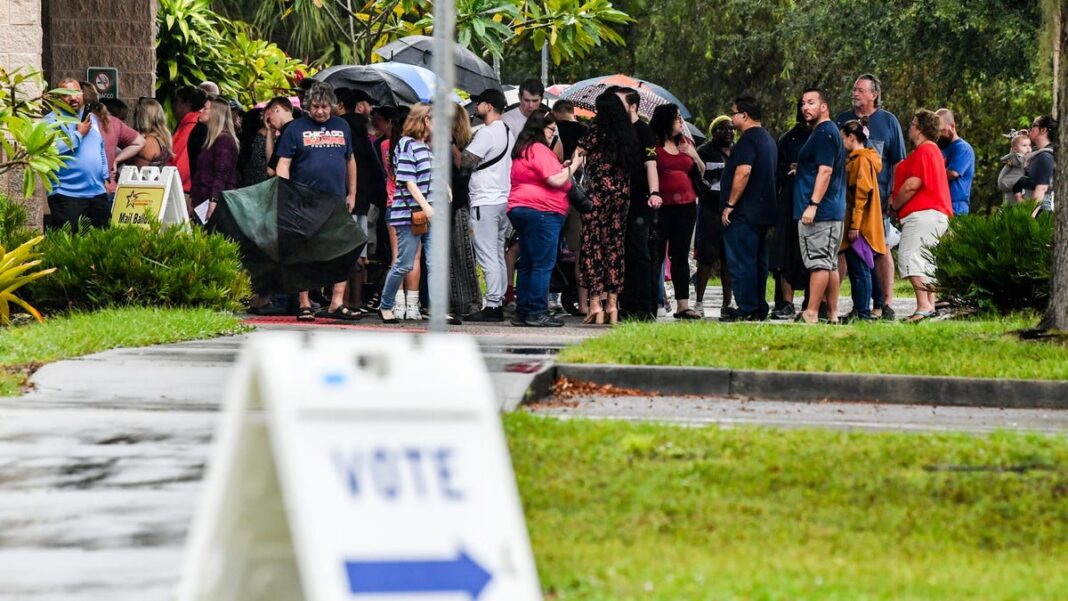Your Election Day weather: What to expect at the polls
Voters in the U.S. will encounter a range of weather conditions on Election Day, from rain and wind to unseasonably warm temperatures.
The worst weather will affect the south-central U.S., where a large storm is expected to bring rain and wind, particularly in the Deep South.
AccuWeather meteorologist Dan Pydynowski warns, “Those waiting in outdoor lines to vote on Tuesday should prepare for potential lightning and heavy rainfall, especially from Louisiana and Arkansas extending northeast into parts of the Mississippi and Ohio Valleys.”
While thunderstorms may be less likely further north, swing states like Wisconsin and Michigan are forecasted to have a chilly, rainy day.
In contrast, voters on the East Coast will experience warm weather with temperatures reaching the 70s as far north as Washington, D.C. Most areas along the West Coast are also expected to remain dry, although some rain and snow showers may occur in the Northwest.
Heavy rain anticipated
A wide region from Houston to Indianapolis may experience significant rainfall on Tuesday, according to AccuWeather meteorologists.
The storm system bringing strong winds and rain on Monday is projected to move eastward into Arkansas, Missouri, and Louisiana by Tuesday, following heavy rains that affected Oklahoma on Monday.
Warm and dry conditions are expected in the eastern U.S. on Election Day, maintaining a dry streak in the Northeast, including New York City.
Parts of the Southeast, including Florida, Georgia, and South Carolina, might experience light showers on Election Day. Voters in the northwest should dress warmly, as cold temperatures and possible snow may also impact their voting experience.
Impact of weather on voter participation
Although weather is typically not seen as a critical factor in voter turnout, some studies indicate that poor weather, especially thunderstorms, can deter people from voting, particularly younger voters, casual voters, and those likely to lean Democratic, according to a report by Journalist’s Resource.
Bill Kirk, CEO of Weathertrends360, also noted that rainfall on Election Day tends to diminish voter turnout, with a study showing that every inch of rain can lead to a 2.5% drop in participation, regardless of political affiliation.
Will there be rain on Election Day?
AccuWeather anticipates rain on Tuesday across a broad section of the central U.S., which includes all areas of Louisiana, eastern Texas, and western Arkansas.
The heaviest rain is likely in a region where northeast Oklahoma meets southeast Kansas and southwest Missouri, which could see between 8 to 12 inches of rainfall.
This stormy weather will follow a wet Monday across central states, including Oklahoma, Missouri, and Iowa.
Rain expected in Wisconsin and Michigan
On Election Day, Wisconsin and Michigan will experience rain, two critical swing states with tight races between former President Donald Trump and Vice President Kamala Harris.
According to AccuWeather Senior Meteorologist Paul Pastelok, Wisconsin should see rainfall primarily in the morning, tapering off later, while Michigan may experience rain throughout the day.
Moreover, voters in northern Iowa and southeastern Minnesota may find it easier to vote dry if they go to the polls later in the day after early rainfall subsides, Pastelok noted.
Flood warnings in Oklahoma
On Monday, flood watches were issued for nearly all of Oklahoma, according to the National Weather Service.
Eastern Oklahoma experienced river flooding on Monday, with forecasters warning of possible severe weather events, including damaging winds, large hail, and tornadoes.
By Monday morning, northern Arkansas had already received between 4 to 8 inches of rain, prompting a flash flood watch in the area.

